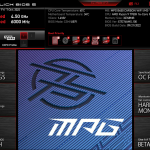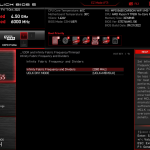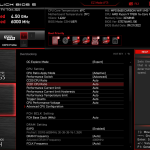MSI’s tried-and-tested UEFI design is found on the B650 Carbon WiFi.
There’s the conventional ‘overview’ page that delivers most information average users would want. This section is quick and easy for viewing current operations and making basic changes.
But jumping into the ‘Advanced’ section opens up a host of user-tweakable options. Notable here is the SSD Secure Erase facility which can be helpful when selling or fixing your SSD. Plus, there is a good amount of control over the integrated GPU configuration.
Fan control through MSI Hardware Monitor is strong. Fan control is handled using a 4-point curve system for Smart Control mode or just a single voltage or PWM duty cycle for static – non-smart – speed.
This 4-point mode is good because the maximum fan speed can be set at a true 0-100% range which is excellent if your cooler can do 0 RPM mode or if you feel it is too loud at 100% fan speed. Plus, you don’t have lower or upper temperature limits.
So, you can keep 0 RPM mode at say 70C CPU temp whilst also forcing the fans to stay below their top speed even at 95C. That is particularly useful for Ryzen 7000 and its 95C running mode.
There is step-up and step-down hysteresis control on all of the fan headers which is superb. Plus, all five temperature sensor sources are available to all fan headers, including the very handy MOSFET temperature input.
Yes, the GUI visual design is clunky and looks archaic. But functionally it is exceptionally good, and the actual information displayed via graphics and numbers is useful.
There are plenty of overclocking options for manual tuning users. But being perfectly honest, these are likely surplus to requirements given how effective AMD’s Precision Boost 2 algorithm is for Ryzen 7000.
Tweaking the core voltage alongside power and temperature allowances is arguably the best way to overclock these new chips. If you want to do adaptive core ratio overclocking and split it at CCD level, that’s possible. There’s ample opportunity to tune the memory. And voltage control options are strong, though MSI’s loadline calibration settings need an explanation rather than a great, big, unhelpful list.
As already noted, overclocking via the ‘new’ methods are plausible. For example, you can go through with a bunch of Precision Boost Overdrive tweaks in AMD’s usual format. Or you can opt for your own determined PPT allowance to the processor. Or, given the discussions over the past days since launch, you can set a temperature target for your processor to run at, rather than a power-driven metric.
It’s just a shame that there is no clear and concise Eco Mode for the CPU via the UEFI. I would have preferred a 105W TDP and 65W TDP option to be clearly included. Particularly as these TDP-driven Eco modes are consistent across CPUs.
I like MSI’s UEFI overall. It is functionally strong and easy to navigate for the simple features, though it does get confusing when going through all of the options sub-pages as there are just so many, some of which seem repeated.
The design and general art or rendering seem archaic. But functionally, the interface is proficient.
 KitGuru KitGuru.net – Tech News | Hardware News | Hardware Reviews | IOS | Mobile | Gaming | Graphics Cards
KitGuru KitGuru.net – Tech News | Hardware News | Hardware Reviews | IOS | Mobile | Gaming | Graphics Cards






























